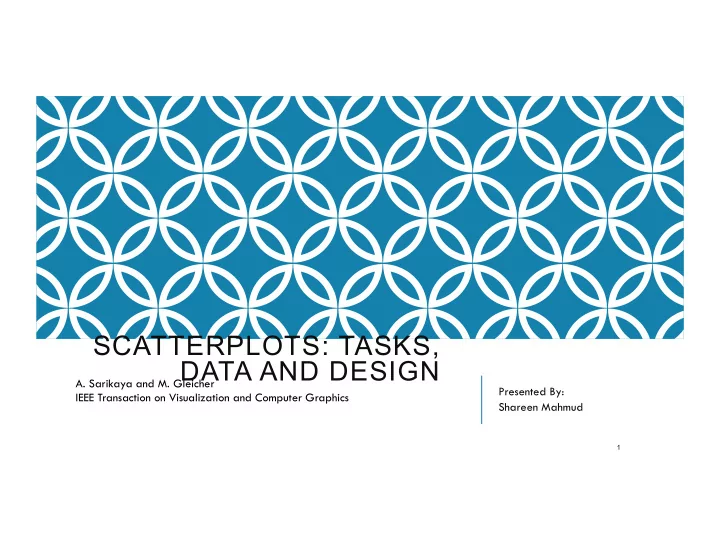

SCATTERPLOTS: TASKS, DATA AND DESIGN A. Sarikaya and M. Gleicher Presented By: IEEE Transaction on Visualization and Computer Graphics Shareen Mahmud 1
WHAT IS A TRADITIONAL SCATTERPLOT? • Encodes two quantitative variables using the vertical and horizontal spatial position channels • Each object in a dataset is represented with a point (mark) • Effective in providing overviews, finding outliers, and judging correlation 2
DOES IT FAIL? • Yes! As data grows in scale, traditional scatterplots can become ineffective • Overdraw is a concern where points overlap one another and masks points drawn under them. HTTPS://ALPER.DATAV.IS/ASSETS/PUBLICATIONS/SCATTERPLOTS/SCATTERPLOT-TALK.PDF 3
DIFFERENT DESIGNS SOLUTIONS Binned Scatterplot Splatterplot Traditional Scatterplot Designers have little guidance in how to select among choices. Which design to choose? HTTPS://ALPER.DATAV.IS/ASSETS/PUBLICATIONS/SCATTERPLOTS/SCATTERPLOT-TALK.PDF 4
GOAL OF THE PAPER • Help designers select scatterplot designs that are appropriate to their scenarios • Identify factors that affect the appropriateness of scatterplot designs • Create a framework based on the analysis goal and data characteristics 5
FACTORS THAT AFFECT THE DESIGN OF SCATTERPLOTS • Analysis Tasks: What do viewers do with a scatterplot? • Data Characteristics: How do they prompt changes in design? • Design Decisions: What design variables need to be constructed? 6
ANALYSIS TASKS • Gathered 23 model tasks from various vis literature to capture what viewers do with scatterplots • Four data visualization experts performed an open card sort where tasks were grouped together based on their similarity • Refined the categories post hoc to generate a complete picture of the task space 7
ANALYSIS TASKS • A final list of 12 tasks split into 3 categories Object Centric Browsing Aggregate Level • A combination of these tasks can be used as building blocks to achieve an analysis goal 8
DATA CHARACTE RISTICS Data characteristics can influence the design of an appropriate scatterplot HTTPS://ALPER.DATAV.IS/ASSETS/PUBLICATIONS/SCATTERPLOTS/SCATTERPLOT-TALK.PDF 9
DATA CHARACTE RISTICS List of design affecting data characteristics collected from the literature 10
DESIGN DECISION • Identified design decisions by applying a keyword (“scatter”) search methodology on 3040 vis papers. • Clustered the design choices into 4 groups Point Encoding (Example: Color) Point Grouping (Example: Binning) Point Position (Example: Animation) Graph Amenities (Example: Annotations ) • Interaction Intent HTTPS://ALPER.DATAV.IS/ASSETS/PUBLICATIONS/SCATTERPLOTS/SCATTERPLOT-TALK.PDF 11
DESIGN SPACE TO EVALUATE APPROPRIATENESS OF DESIGN STRATEGIES Cross product of these three is huge! Leads to over 4300 discrete scatterplot scenarios HTTPS://ALPER.DATAV.IS/ASSETS/PUBLICATIONS/SCATTERPLOTS/SCATTERPLOT-TALK.PDF 12
A SLICE OF THE SPACE: TASK & DESIGN STRATEGIES • Framework illustrated with a 2D slice of the entire grid (60 out of 4300 grids) • Entire set of tasks and design strategies • Data characteristics fixed to “large” number of points and classes with an unstructured distribution of data 13
USING THE FRAMEWORK • Difficult to support aggregate level tasks such as identifying anomalies, correlations and object density with point encoding and position (9A-11B) HTTPS://ALPER.DATAV.IS/ASSETS/PUBLICATIONS/SCATTERPLOTS/SCATTERPLOT-TALK.PDF 14
USING THE FRAMEWORK • Point grouping hurts object-centric tasks (1C-4C, 9C, 12C) • However, by compositing point encoding, point position and interaction intent, object centric tasks can be supported. HTTPS://ALPER.DATAV.IS/ASSETS/PUBLICATIONS/SCATTERPLOTS/SCATTERPLOT-TALK.PDF 15
WHAT-WHY-HOW ANALYSIS Idiom Scatterplots (Framework) What: Data Vis literature; papers What: Derived Table with Tasks, Data characteristics, Design choices Why: Tasks Compare design strategies How: Encode Multidimensional table, Color highlighting, marks to denote appropriateness of design decisions How: Reduce Dimensionality Reduction/Slicing Scale 4300 scatterplot scenarios 16
STRENGTH AND LIMITATIONS • Strengths - First to identify scenarios specific to scatterplot design - Provides scope to discover potential areas for future innovation in scatterplot design - Provides a good reference point for designers to get started with scatterplot design • Limitation - Infeasible to present the high dimensional grid. Data characteristics were restricted - Focuses on single scatterplot design. Multi scatterplot tasks were discarded - Misses the evaluation component is the study. How useful did designers find this framework to be? 17
REFERENCES Paper: https://alper.datav.is/assets/publications/scatterplots/scatterplots-preprint.pdf Slides: https://alper.datav.is/assets/publications/scatterplots/scatterplot-talk.pdf Project Page: http://graphics.cs.wisc.edu/Vis/scattertasks/ 18
Recommend
More recommend